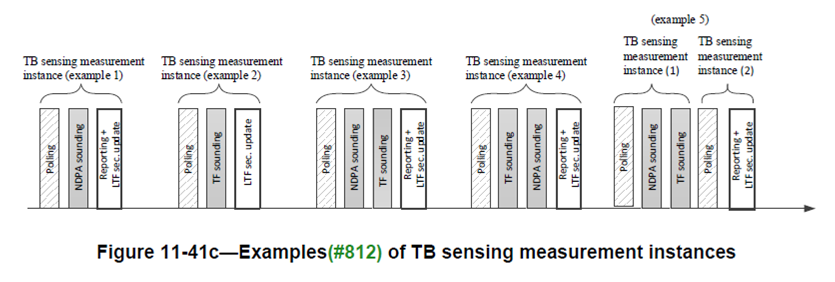Maybe we can have a “middle ground”. I do not think there is any confusion about example 1, 2, 3, and 4 in the figure. Example 5 is probably confusing.
So, how about removing example 5 and keep other examples? Later on, if we decide the ordering of TF and NDPA sounding, then one of ex 3 or 4 will have to go.
Otherwise, when looking at Fig 11-41d along with Dongguk’s figure, it may not be immediately apparent (for someone reading the spec for the first
time) that some of the phases can be absent in an MI.
thanks and regards
-Anirud
Anirudha (Anirud) Sahoo (He/Him)
https://sites.google.com/view/a-sahoo
National Institute of Standards and Technology
Wireless Networks Division
Communications Technology Lab
100 Bureau Drive, Stop 6730
Gaithersburg, MD 20899
Ph: 301-975-4439
From: Dong Wei <dong.wei@xxxxxxx>
Sent: Tuesday, September 13, 2022 5:37 PM
To: Ali Raissinia <alirezar@xxxxxxxxxxxxxxxx>; Sahoo, Anirudha (Fed) <anirudha.sahoo@xxxxxxxx>; STDS-802-11-TGBF@xxxxxxxxxxxxxxxxx
Subject: RE: [EXT] RE: Discussion for the example of TB sensing measrurement instance
Dear all,
I would like to support Dongguk’s new approach as it significantly reduces the confusion and ambiguity.
Regards,
Dong
From:
stds-802-11-tgbf@xxxxxxxxxxxxxxxxx <stds-802-11-tgbf@xxxxxxxxxxxxxxxxx>
On Behalf Of Ali Raissinia
Sent: Tuesday, September 13, 2022 4:27 PM
To: Sahoo, Anirudha (Fed) <anirudha.sahoo@xxxxxxxx>;
STDS-802-11-TGBF@xxxxxxxxxxxxxxxxx
Subject: [EXT] RE: Discussion for the example of TB sensing measrurement instance
Caution: EXT Email
I tend to support Dongguk’s new approach by replacing the exiting diagrams and come up with one with list scenarios (for different devices) to highlight
which phase(s) would be absent. It is much simpler and less confusing as to the TB sequence and the order in which they would appear (if present).
This would be convey the same thing that is currently showing in the current diagrams.
Regards,
Ali
From: Sahoo, Anirudha (Fed) <00001823ca88828f-dmarc-request@xxxxxxxxxxxxxxxxx>
Sent: Tuesday, September 13, 2022 11:10 AM
To: STDS-802-11-TGBF@xxxxxxxxxxxxxxxxx
Subject: Re: [STDS-802-11-TGBF] Discussion for the example of TB sensing measrurement instance
WARNING:
This email originated from outside of Qualcomm. Please be wary of any links or attachments, and do not enable macros.
Hi Dongguk,
I like Figure 11-41c as it is depicted currently in D0.2. It shows different combinations of TB MI, (it is ok if it may not be exhaustive). Replacing
it with just a simple one that you suggested will make it difficult for someone, who reads the spec for the first time, to visualize different signaling combinations. Looking at this figure one immediately gets the idea that a TB MI can have many different
types of signaling. So, I suggest that we keep those combinations currently in the draft and work to remove ambiguity. Some combination may not be correct. For example, if/when we decide the order of TF and NDPA sounding, either example 3 or 4 would become
wrong. Also, I am confused about example 5, but we can correct/clarify example 5. In summary, I would urge not to get rid of those different cases of TB MI, but rather work on making it clear or unambiguous.
thanks and regards
-Anirud
Anirudha (Anirud) Sahoo (He/Him)
https://sites.google.com/view/a-sahoo
National Institute of Standards and Technology
Wireless Networks Division
Communications Technology Lab
100 Bureau Drive, Stop 6730
Gaithersburg, MD 20899
Ph: 301-975-4439
From:
stds-802-11-tgbf@xxxxxxxxxxxxxxxxx <stds-802-11-tgbf@xxxxxxxxxxxxxxxxx>
On Behalf Of Dongguk Lim
Sent: Tuesday, September 13, 2022 4:26 PM
To: STDS-802-11-TGBF@xxxxxxxxxxxxxxxxx
Cc: hg.cho@xxxxxxx
Subject: Discussion for the example of TB sensing measrurement instance
Hi All,
I hope you are being well.
When I presented the DCN 22/1330r0 in the previous 11bf CC, we have a lot of discussion regarding the examples of TB sensing measurement instances described in figure 11-41c.
To illustrate the various examples for the TB sensing measurement instance, we considered showing some considered examples of the TB sensing measurement instance.

However, as you felt in during the previous CC, due to various examples described in figure 11-41c, it occurred a misunderstanding and ambiguity in the configuration of the TB sensing measurement instance.
Since it is just an example to explain the TB sensing measurement, I think that we can simply the figure 11-41c with a figure which includes only one example as below to avoid misunderstanding and ambiguities.

Figure 11-41c Example of a TB sensing measruement instance
Also, regarding this figure, we can consider the modification of figure 11-41d, for the explanation of the operation for the STAs participating in this TB sensing measurement instance.
After the discussion for the change, if we determine to change figure 11-41 with the suggested one, I will also provide the modification of figure 11-41d regarding the description together.
In addition, even though the figure(11-41c) is modified as including only one example, we can have more time to discuss the issues related to the TB sensing measurement instance, for example, the order
of each phase, configuration, etc.
I would like to hear your opinions on the suggested change regarding figures 11-41.
Please feel free to give your opinions..
Best regards,
Dongguk.
________________________________________________________________________________________
Dongguk Lim
Chief Technology Officer IoT Connectivity Standard Task/Professional
LG Electronics Inc
19, Yangjae-daero 11-gil, Seocho-gu, Seoul, Korea
M.82-10-8996-4690
E.dongguk.lim@xxxxxxx
___________________________________________________________________
To unsubscribe from the STDS-802-11-TGBF list, click the following link:
https://listserv.ieee.org/cgi-bin/wa?SUBED1=STDS-802-11-TGBF&A=1
To unsubscribe from the STDS-802-11-TGBF list, click the following link:
https://listserv.ieee.org/cgi-bin/wa?SUBED1=STDS-802-11-TGBF&A=1
To unsubscribe from the STDS-802-11-TGBF list, click the following link:
https://listserv.ieee.org/cgi-bin/wa?SUBED1=STDS-802-11-TGBF&A=1
To unsubscribe from the STDS-802-11-TGBF list, click the following link: https://listserv.ieee.org/cgi-bin/wa?SUBED1=STDS-802-11-TGBF&A=1